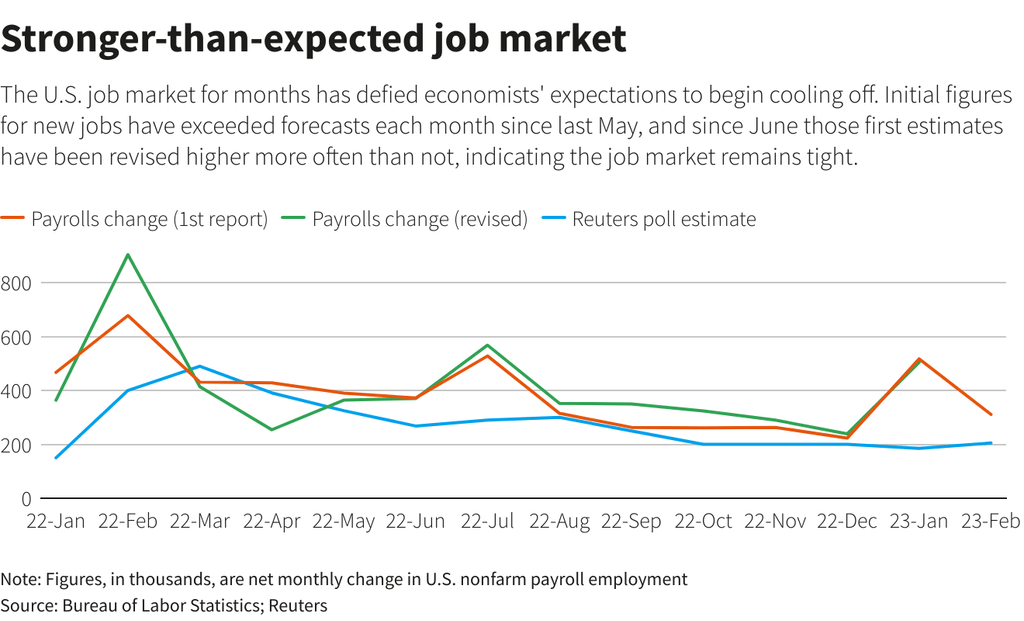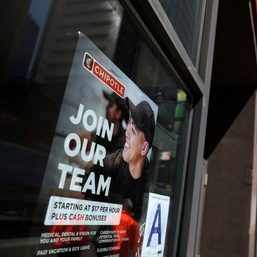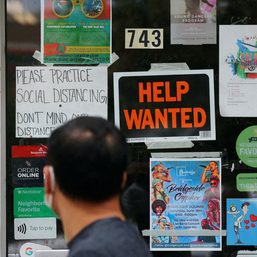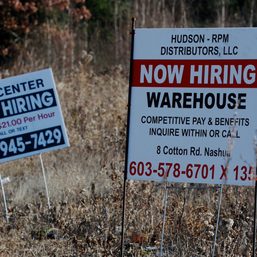SUMMARY
This is AI generated summarization, which may have errors. For context, always refer to the full article.

WASHINGTON, USA – The US economy added jobs at a brisk clip in February, but monthly wage growth slowed and the unemployment rate rose, pointing to some labor market loosening and prompting financial markets to dial back expectations that the Federal Reserve would raise interest rates by half a percentage point this month.
The Department of Labor’s closely watched employment report on Friday, March 10, also showed labor supply swelled last month, helping to lift the share of the prime-age population in the labor force to the highest level since just before the COVID-19 pandemic.
Some economists viewed the mixed report as raising the chances that the economy would avoid a much feared recession this year, and instead only experience slower growth.
“This is a strong foundation for the economy,” said Nick Bunker, head of economic research at the Indeed Hiring Lab. “If wages continue to grow around its current rate or even a bit higher, the labor market may be able to stay strong and not throw gas on the inflation fire.”
Nonfarm payrolls increased by 311,000 jobs last month, the survey of establishments showed. Data for January was revised lower to show 504,000 jobs added instead of the previously reported 517,000. But the growth in employment was not as broad as in prior months, with only 56% of industries adding to payrolls compared to 68% in February. That was the lowest share since April 2020, when pandemic lockdowns were in place.
Economists polled by Reuters had forecast job growth of 205,000, with estimates ranging from 78,000 to 325,000. The economy needs to create 100,000 jobs per month to keep up with growth in the working-age population.

The larger-than-expected increase in payrolls suggested that January’s surge in hiring was not a fluke.
Economists had viewed job growth in January as flattered by a host of factors, including unseasonably warm weather, annual benchmark revisions to the data, as well as overly generous seasonal adjustment factors, the model the government uses to strip out seasonal fluctuations from the data.
The leisure and hospitality sector accounted for a third of the jobs created last month, adding 105,000 positions, the bulk of them at restaurants and bars. Employment in leisure and hospitality remains 410,000 jobs below its pre-pandemic level.
Retailers hired 50,100 more workers, while government payrolls increased by 46,000 jobs.
Employment in professional and business services rose by 45,000 jobs and healthcare added 44,000 positions. Construction payrolls grew by 24,000 jobs, but manufacturing employment dropped 4,000. The information industry shed 25,000 jobs, while transportation and warehousing lost 21,500 positions.

Average hourly earnings rose 0.2% last month after gaining 0.3% in January, with most sectors experiencing a slowdown. That raised the year-on-year increase in wages to 4.6% from 4.4% in January, partly due to last year’s flat reading dropping out of the calculation. Wage growth slowed to a three-month annualized pace of 3.6% from a 4.4% rate.
“Progress on inflation can be made without torpedoing employment,” said Sarah House, a senior economist at Wells Fargo in Charlotte, North Carolina. “The recent pace, if sustained, gets earnings growth within the realm of what would be consistent with 2% inflation assuming the recent trend in productivity growth continues.”
Financial markets now expect a quarter-percentage-point rate hike at the end of the Fed’s March 21-22 policy meeting, instead of the 50-basis-point increase that been anticipated before the report, according to CME Group’s FedWatch tool.
Much will, however, depend on February’s consumer prices report next week. Troubles at SVB Financial Group, which have pressured global banking shares, could have an impact on the future course of monetary policy.
Stocks on Wall Street were trading lower. The dollar fell against a basket of currencies. US Treasury prices rose.
Unemployment rate rises
“We’ll need to understand the implications of SI (Silvergate Capital) and SVB on the overall banking sector, specifically from a systemic perspective as to what to expect next from the Fed,” said John Luke Tyner, portfolio manager and fixed-income analyst at Aptus Capital Advisors in Fairhope, Alabama.
Fed Chair Jerome Powell told lawmakers this week that the US central bank would likely need to raise rates more than expected. The Fed has increased its policy rate by 450 basis points since last March from the near-zero level to the current 4.50%-4.75% range.
While the labor market remains tight, with 1.9 job openings for every unemployed person in January, it is fraying a bit around the edges. The average workweek fell to 34.5 hours from 34.6 in January, suggesting that many of the jobs being created could be part-time.
The household survey from which the unemployment rate is derived, showed an increase in the number of people who said they were working part-time because of slack work or business conditions. Still, the overall number of people working part-time for economic reasons was little changed.
The unemployment rate rose to 3.6% in February from 3.4% in January, which was the lowest since May 1969.

The increase occurred as 419,000 people entered the labor force, 227,000 of them women, lifting the participation rate to 62.5%, from 62.4% in January. That was the highest level in the participation rate – the share of working-age Americans who either have a job or are looking for one – since March 2020.
The participation rate for the 25-54 age group shot up to 83.1%, the highest since January 2020, from 82.7% in January. It has now more than fully recovered for women, millions of whom had to drop out of the labor force during the COVID-19 pandemic mostly because of childcare pressures.
“Stronger rates of participation could help companies fill open positions and ease wage growth pressures going forward,” said Julia Pollak, chief economist at ZipRecruiter. – Rappler.com
Add a comment
How does this make you feel?

![[OPINION] A rebellion long overdue](https://www.rappler.com/tachyon/2024/06/mass-uprising-matrix-june-4-2024.jpg?resize=257%2C257&crop_strategy=attention)













There are no comments yet. Add your comment to start the conversation.